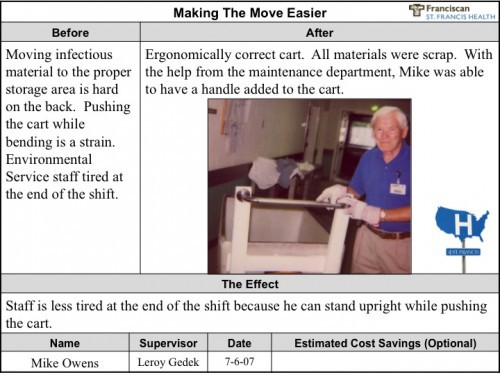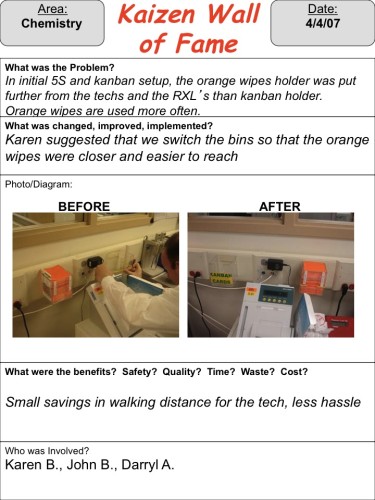As regular readers know, I'm working on a second book: Healthcare Kaizen: Engaging Front-Line Staff in Sustainable Improvements. My co-author, Joe Swartz, and I have a lot of examples of “daily kaizen” that will be shared in the book. The idea isn't to copy the specific ideas as much as it is to illustrate the methods for getting, implementing, and sustaining small, low-cost, low-risk improvements that make people's work easier and improve patient care.
Do you have examples you would want to share and maybe have published?
Joe's organization, Franciscan St. Francis Health, has been using the “Quick and Easy Kaizen” method, as taught by Norman Bodek, for at least five years with great results. In this method, improvements are written up in a “Kaizen Report,” as shown below:
It's a simple, yet effective method for documenting and recognizing improvements, no matter how small. Tell (or show!) the before and after and write a statement about the impact of the improvement.
Also featured in the book are examples from other organizations I have worked with, where we have used “visual idea boards” (instead of ineffective suggestion boxes) and what one client of mine dubbed the “Kaizen Wall of Fame” report, as shown below, in a picture from my first book, Lean Hospitals: Improving Quality, Patient Safety, and Employee Satisfaction:
Do you have similar examples from your healthcare organization that you would want to share and maybe have published in our book? If so, email Mark. Or, you can post a description of your kaizen methods in the comments for other readers to learn from… if you use Norman Bodek's approach or any other variation (inspired by Lean Hospitals or otherwise), it would be great to hear about it even if you're not looking to get an example published.
If you have examples of “kaizen events” (aka Rapid Improvement Events or Rapid Process Improvement Workshops), that's really a topic for a different book (and good books on kaizen events have already been written, such as The Kaizen Event Planner: Achieving Rapid Improvement in Office, Service, and Technical Environments and Kaizen Event Fieldbook: Foundation, Framework, and Standard Work for Effective Events
).
Joe and I are passionate about daily continuous improvement and feel that's been an under appreciated topic in healthcare. There's been a lot of fuss about week-long events and for good reason – you can get great results from them, as organizations like ThedaCare, Virginia Mason, and others demonstrate. But both organizations have moved toward a more balanced approach of using both events AND daily continuous improvement. We briefly discuss kaizen events as one of the modes of improvement within the Lean and kaizen frameworks… but you can already about events (and their Lean culture) in the books about THOSE two organizations: On the Mend: Revolutionizing Healthcare to Save Lives and Transform the Industry and Transforming Health Care: Virginia Mason Medical Center's Pursuit of the Perfect Patient Experience
.
![]() photo credit: Chuck “Caveman” Coker
photo credit: Chuck “Caveman” Coker
Please scroll down (or click) to post a comment. Connect with me on LinkedIn.
Let’s build a culture of continuous improvement and psychological safety—together. If you're a leader aiming for lasting change (not just more projects), I help organizations:
- Engage people at all levels in sustainable improvement
- Shift from fear of mistakes to learning from them
- Apply Lean thinking in practical, people-centered ways
Interested in coaching or a keynote talk? Let’s talk.
Join me for a Lean Healthcare Accelerator Trip to Japan! Learn More












Quick and Easy kaizen is a simple but powerful concept. It meshes well into Healthcare processes like daily huddles and doctor rounds. The key is finding a bit of time every day to keep making improvements. It doesn’t take long before people can look back and say “Wow – we’ve come a long way over the past few months”
Yes, it’s very powerful! Often easier said than done, though… “lack of time” is cited as a barrier. We’re trying to address this and other common barriers to kaizen (and strategies to get past them) in the book!
Sometimes you just have to MAKE the time to kaizen, eh?
Hi Mark,
I am a huge fan of QnEK. Love ‘harnessing’ the creative power of people. Having the impetuous to make your work easier, more interesting or safer brings empowerment.
Do the typical boundaries work in healthcare? What I know of them are:
1. Doesn’t cost any (or little) money.
2. Doesn’t make someone else’s work harder.
3. You can get it done.
How about the regulatory requirements? I understand there is a lot that we do in healthcare for reasons that aren’t known by the people doing the work. For example, I wouldn’t want staff at a registration desk to stop having patients fill out a form. Are there examples of this type of boundary in a QnEK initiative?
Thanks! I look forward to deploying and providing examples for your new book! – Matt
Matt – sorry for the slow response on your comment.
Yes, the same boundaries you talk about apply in healthcare. Kaizen should be small, easy, low-cost, low-risk improvements.
Part of the Kaizen dynamic is that staff are working with each other and their supervisors on improvement. In the QnEK approach, people aren’t fully empowered to do whatever they want. If you make a small improvement, you write it up and discuss it with your supervisor. There’s an “approval” step, but it’s collaborative, coaching, and teaching – not just a yes/no vote done in isolation.
If a person made or suggested a change that would cause problems for others, that’s a learning opportunity. I think generally people have the sense to be cautious about things that might cause major problems for patients. For things more complicated than the simplest QnEK, there’s again a process of dialogue between managers and staff – nothing really happens in isolation.
Does that help? Your reactions?
Since we’ve talked before, I might recruit you to read and give feedback on our manuscript (some of the chapters that address these issues) before we submit it to the publisher.
Great post! I’m looking to implement quick changes in my hospital. We have done a lot work in planning Kaizen events and laying out projects as a result of them. These put a lot of strain on resources and sometimes they break out into long term projects, which I don’t think is the essence of Kaizen.
I’d like to get going with some daily events like 5S’s etc. like you have here. It’s a good way to get buy in from the staff and prove that you’re truly there to help. Plus you actually get results, albeit small, which gives reassurance to upper management.
The (week long) Kaizen events tend to focus on the largest areas of concern, like ED LoS, Discharge delays etc., while there are many small improvements that can be made in all areas of the hospital.
Events are just one form of “kaizen” if you define kaizen as “change for the better.” But Kaizen is really, in essence, about “continuous improvement.” There’s nothing continuous about scattered, episodic events.
Events can (and should) be used for the right scope, size, and complexity of problem. But not everything needs to be an event. That’s where “quick and easy kaizen” and the stuff in our upcoming book comes in.
Events and daily Kaizen are complementary in nature. Doing one helps you get better at the other and vice versa. We’ll have stories and examples of such in the book.
[…] is a book about real-world practice. Joe Swartz brings tons of experiences, quotes, and Kaizen examples from his 5 years of working for the Franciscan St. Francis Health System in Indiana. They have […]
Please suggest some good kaizen for Office which helps in reducing cost , improving quality standards,etc.
All you can do is look around your office for Kaizen opportunities. Talk to your colleagues. What bugs you? What problems can be eliminated? How can delays be reduced?
Comments are closed.